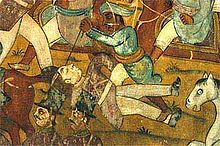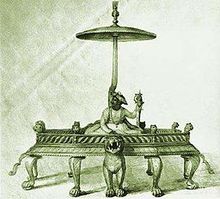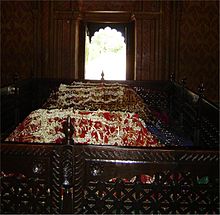The History Of Badshah Tipu Sultan.
Tipu Sultan
| Tipu Sultan | |||||
|---|---|---|---|---|---|
| Badshah Nasib ad-Dawlah Sultan Mir Fateh Ali Bahadur Tipu | |||||
 | |||||
| Sultan of Mysore | |||||
| Reign | 10 December 1782 – 5 May 1799 | ||||
| Coronation | 29 December 1782 | ||||
| Predecessor | Hyder Ali | ||||
| Successor | Krishnaraja Wodeyar III | ||||
| Born | 20 November 1750[1] Devanahalli, present-day Bangalore, Karnataka | ||||
| Died | 4 May 1799 (aged 48) Srirangapatna, present-day Mandya, Karnataka | ||||
| Burial | |||||
| |||||
| House | Mysore | ||||
| Father | Hyder Ali | ||||
| Mother | Fatima Fakhr-un-Nisa | ||||
| Religion | Islam | ||||
Tipu Sultan (born Sultan Fateh Ali Sahab Tipu, 20 November 1750 – 4 May 1799), also known as the Tipu sahab was a ruler of the Kingdom of Mysore. He was the eldest son of Sultan Hyder Ali of Mysore. Tipu Sultan introduced a number of administrative innovations during his rule, including his coinage, a new Mauludi lunisolar calendar, and a new land revenue system which initiated the growth of the Mysore silk industry. He expanded the iron-cased Mysorean rockets and commissioned the military manual Fathul Mujahidin, and is considered a pioneer in the use of rocket artillery. He deployed the rockets against advances of British forces and their allies during the Anglo-Mysore Wars, including the Battle of Pollilur and Siege of Seringapatam. He also embarked on an ambitious economic development program that established Mysore as a major economic power, with some of the world's highest real wages and living standards in the late 18th century.
Napoleon Bonaparte, the French commander-in-chief, sought an alliance with Tipu Sultan. Both Tipu Sultan and his father used their French-trained army in alliance with the French in their struggle with the British, and in Mysore's struggles with other surrounding powers, against the Marathas, Sira, and rulers of Malabar, Kodagu, Bednore, Carnatic, and Travancore. Tipu's father, Hyder Ali, rose to power capturing Mysore, and Tipu succeeded Mysore upon his father's death in 1782. He won important victories against the British in the Second Anglo-Mysore War and negotiated the 1784 Treaty of Mangalore with them after his father died from cancer in December 1782 during the Second Anglo-Mysore War.
Tipu's conflicts with his neighbours included the Maratha–Mysore War which ended with the signing the Treaty of Gajendragad The treaty required that Tipu Sultan pay 4.8 million rupees as a one time war cost to the Marathas, and an annual tribute of 1.2 million rupees in addition to returning all the territory captured by Hyder Ali.
Tipu remained an implacable enemy of the British East India Company, sparking conflict with his attack on British-allied Travancore in 1789. In the Third Anglo-Mysore War, he was forced into the Treaty of Seringapatam, losing a number of previously conquered territories, including Malabar and Mangalore. He sent emissaries to foreign states, including the Ottoman Empire, Afghanistan, and France, in an attempt to rally opposition to the British.
In the Fourth Anglo-Mysore War, the imperial forces of the British East India Company were supported by the Nizam of Hyderabad and Marathas. They defeated Tipu, and he was killed on 4 May 1799 while defending his fort of Srirangapatna.
He was one of the few South Indian kings to provide stiff resistance to British imperialism, along with his father Hyder Ali. He is applauded as a ruler who fought against British colonialism.
Early years
Childhood
Tipu Sultan was born on 20 November 1750 (Friday, 20th Dhu al-Hijjah, 1163 AH) at Devanahalli, in present-day Bangalore Rural district, about 33 km (21 mi) north of Bangalore city. He was named "Tipu Sultan" after the saint Tipu Mastan Aulia of Arcot. Being illiterate, Hyder was very particular in giving his eldest son a prince's education and a very early exposure to military and political affairs. From the age of 17 Tipu was given independent charge of important diplomatic and military missions. He was his father's right arm in the wars from which Hyder emerged as the most powerful ruler of southern India.
Tipu's father, Hyder Ali, was a military officer in service to the Kingdom of Mysore who had become the de facto ruler of Mysore in 1761 while his mother Fatima Fakhr-un-Nisa was the daughter of Mir Muin-ud-Din, the governor of the fort of Kadapa. Hyder Ali appointed able teachers to give Tipu an early education in subjects like Urdu, Persian, Arabic, Kannada, Quran, Islamic jurisprudence, riding, shooting and fencing.
Early military service
Tipu Sultan was instructed in military tactics by French officers in the employment of his father. At age 15, he accompanied his father against the British in the First Mysore War in 1766. He commanded a corps of cavalry in the invasion of Carnatic in 1767 at age 16. He also distinguished himself in the First Anglo-Maratha War of 1775–1779.
Alexander Beatson, who published a volume on the Fourth Mysore War entitled View of the Origin and Conduct of the War with Tippoo Sultaun, described Tipu Sultan as follows: "His stature was about five feet eight inches; he had a short neck, square shoulders, and was rather corpulent: his limbs were small, particularly his feet and hands; he had large full eyes, small arched eyebrows, and an aquiline nose; his complexion was fair, and the general expression of his countenance, not void of dignity".
Second Anglo-Mysore War
In 1779, the British captured the French-controlled port of Mahé, which Tipu had placed under his protection, providing some troops for its defence. In response, Hyder launched an invasion of the Carnatic, with the aim of driving the British out of Madras.[37] During this campaign in September 1780, Tipu Sultan was dispatched by Hyder Ali with 10,000 men and 18 guns to intercept Colonel Baillie who was on his way to join Sir Hector Munro. In the Battle of Pollilur, Tipu decisively defeated Baillie. Out of 360 Europeans, about 200 were captured alive, and the sepoys, who were about 3800 men, suffered very high casualties. Munro was moving south with a separate force to join Baillie, but on hearing the news of the defeat he was forced to retreat to Madras, abandoning his artillery in a water tank at Kanchipuram.
Tipu Sultan defeated Colonel Braithwaite at Annagudi near Tanjore on 18 February 1782. Braithwaite's forces, consisting of 100 Europeans, 300 cavalry, 1400 sepoys and 10 field pieces, was the standard size of the colonial armies. Tipu Sultan seized all the guns and took the entire detachment prisoner. In December 1781 Tipu Sultan successfully seized Chittur from the British. Tipu Sultan had thus gained sufficient military experience by the time Hyder Ali died on Friday, 6 December 1782 – some historians put it at 2 or 3 days later or before, (Hijri date being 1 Muharram, 1197 as per some records in Persian – there may be a difference of 1 to 3 days due to the Lunar Calendar). Tipu Sultan realised that the British were a new kind of threat in India. He became the ruler of Mysore on Sunday, 22 December 1782 (The inscriptions in some of Tipu's regalia showing it as 20 Muharram, 1197 Hijri – Sunday), in a simple coronation ceremony. He then worked on to check the advances of the British by making alliances with the Marathas and the Mughals. The Second Mysore War came to an end with the 1784 Treaty of Mangalore.
Ruler of the Mysore
In 1780, Tipu crowned himself Badshah or Emperor of Mysore, and struck coinage.
Conflicts with Maratha Confederacy
The Maratha Empire, under its new Peshwa Madhavrao I, regained most of Indian subcontinent, twice defeating Tipu's father, who was forced to accept Maratha Empire as the supreme power in 1764 and then in 1767. In 1767 Maratha Peshwa Madhavrao defeated both Hyder Ali and Tipu Sultan and entered Srirangapatna, the capital of Mysore. Hyder Ali accepted the authority of Madhavrao who gave him the title of Nawab of Mysore.
However Tipu Sultan wanted to escape from the treaty of Marathas and therefore tried to take some Maratha forts in Southern India, which were captured by Marathas in the previous war. Tipu also stopped the tribute to Marathas which was promised by Hyder Ali. This brought Tipu in direct conflict with the Marathas, leading to Maratha–Mysore War
Conflicts between Mysore (under Tipu) and Marathas:
- Siege of Nargund during February 1785 won by Mysore
- Siege of Badami during May 1786 in which Mysore surrendered
- Siege of Adoni during June 1786 won by Mysore
- Battle of Gajendragad, June 1786 won by Marathas
- Battle of Savanur during October 1786 won by Mysore
- Siege of Bahadur Benda during January 1787 won by Mysore
Conflict ended with Treaty of Gajendragad in March 1787, as per which Tipu returned all the territory captured by Hyder Ali to Maratha Empire. Tipu agreed to pay four year arrears of tribute which his father Hyder Ali had agreed to pay to Maratha Empire (4.8 million rupees), The Marathas agreed to address Tipu sultan as "Nabob Tipu Sultan Futteh Ally Khan".
Assessment and legacy
Assessments of Tipu Sultan have often been passionate and divided. Successive Indian National Congress governments have often celebrated Tipu Sultan's memory and monuments and relics of his rule while the Bharatiya Janata Party has been largely critical. School and college textbooks in India officially recognize him as a "freedom-fighter" along with many other rulers of the 18th century who fought European powers.
In 1990, a television series on him, The Sword of Tipu Sultan was directed by Bollywood actor Sanjay Khan and based on a historical novel by Bhagwan Gidwani.
Family
- Shahzada Sayyid walShareef Hyder Ali Khan Sultan (1771 – 30 July 1815)
- Shahzada Sayyid walShareef Abdul Khaliq Khan Sultan (1782 – 12 September 1806)
- Shahzada Sayyid walShareef Muhi-ud-din Ali Khan Sultan (1782 – 30 September 1811)
- Shahzada Sayyid walShareef Mu'izz-ud-din Ali Khan Sultan (1783 – 30 March 1818)
- Shahzada Sayyid walShareef Mi'raj-ud-din Ali Khan Sultan (1784? – ?)
- Shahzada Sayyid walShareef Mu'in-ud-din Ali Khan Sultan (1784? – ?)
- Shahzada Sayyid walShareef Muhammad Yasin Khan Sultan (1784 – 15 March 1849)
- Shahzada Sayyid walShareef Muhammad Subhan Khan Sultan (1785 – 27 September 1845)
- Shahzada Sayyid walShareef Muhammad Shukrullah Khan Sultan (1785 – 25 September 1830)
- Shahzada Sayyid walShareef Sarwar-ud-din Khan Sultan (1790 – 20 October 1833)
- Shahzada Sayyid walShareef Muhammad Nizam-ud-din Khan Sultan (1791 – 20 October 1791)
- Shahzada Sayyid walShareef Muhammad Jamal-ud-din Khan Sultan (1795 – 13 November 1842)
- Shahzada Sayyid walShareef Munir-ud-din Khan Sultan (1795 – 1 December 1837)
- His Highness Shahzada Sir Sayyid walShareef Ghulam Muhammad Sultan Sahib, KCSI (March 1795 – 11 August 1872)
- Shahzada Sayyid walShareef Ghulam Ahmad Khan Sultan (1796 – 11 April 1824)
- Shahzada Sayyid walShareef Hashmath Ali Khan Sultan (expired at birth)
Tipu had several wives. One of his wives quite renowned for her beauty and intelligence was Sindh Sahiba whose grandson was Sahib Sindh Sultan also known as His Highness Shahzada Sayyid walShareef Ahmed Halim-az-Zaman Khan Sultan Sahib. Tipu Sultan's family was sent to Calcutta by the British. A descendant of one of Tipu Sultan's uncles Noor Inayat Khan was a British Special Operations Executive agent during the Second World War, murdered in the German Dachau concentration camp in 1944. Many other descendants continue to live in Kolkata.
Tipu Jayanti
On 10 November 2017, the Government of Karnataka under the leadership of Chief Minister Siddaramaiah celebrated Tipu's birth anniversary as Tipu Jayanti
Lok Sabha Congress leader, Mallikarjuna Kharge, hit back at the RSS, asking,
Death
Fourth Anglo-Mysore War
Horatio Nelson defeated François-Paul Brueys D'Aigalliers at the Battle of the Nile in Egypt in 1798. Three armies marched into Mysore in 1799—one from Bombay and two British, one of which included Arthur Wellesley. They besieged the capital Srirangapatna in the Fourth Mysore War. There were more than 26,000 soldiers of the British East India Company, approximately 4,000 Europeans and the rest Indians. A column was supplied by the Nizam of Hyderabad consisting of ten battalions and more than 16,000 cavalry. Thus, the soldiers in the British force numbered more than 50,000, whereas Tipu Sultan had only about 30,000.
The British broke through the city walls, and French military advisers told Tipu Sultan to escape via secret passages, but he replied, "Better to live one day as a tiger than a thousand years as a sheep". Tipu Sultan died defending his capital on 4 May.
Tipu Sultan was killed at the Hoally (Diddy) Gateway, which was located 300 yards (270 m) from the N.E. Angle of the Srirangapatna Fort. He was buried the next afternoon at the Gumaz, next to the grave of his father. Many members of the British East India Company believed that Nawab of Carnatic Umdat Ul-Umra secretly provided assistance to Tipu Sultan during the war and sought his deposition after 1799.













Comments
Post a Comment